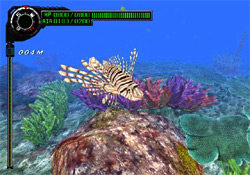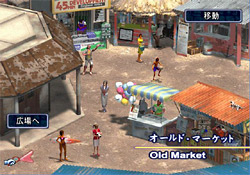Everblue 2
 The “vacation game” came into its own as a genre beginning around 1999, with it games like the Aquanaut’s Holiday series, Kita he, Boku no Natsuyasumi, Dead or Alive Xtreme Beach Volleyball, and others. They are vacations not just because of their generally-idyllic settings and touristy gameplay tasks, but in the way that their gameplay often offers a vacation from other types of games, with simple operation, simple goals, and preferably little irritation to stand in the way. While it may be easy to pass this style off as shallow and slight, it’s refreshing to take a break from memorizing moves and level layouts once in a while.
The “vacation game” came into its own as a genre beginning around 1999, with it games like the Aquanaut’s Holiday series, Kita he, Boku no Natsuyasumi, Dead or Alive Xtreme Beach Volleyball, and others. They are vacations not just because of their generally-idyllic settings and touristy gameplay tasks, but in the way that their gameplay often offers a vacation from other types of games, with simple operation, simple goals, and preferably little irritation to stand in the way. While it may be easy to pass this style off as shallow and slight, it’s refreshing to take a break from memorizing moves and level layouts once in a while.
Everblue 2 is another example of the style. It’s set on a sunny island in the Caribbean and casts the player as a SCUBA diver and explorer who salvages shipwrecks for a living, and who has just been shipwrecked himself near the island, along with his partner from the first Everblue. Not having much to do at first, the main character continues his salvage trade and gradually becomes entangled with the residents of the island. Soon he’s involved in a plot that involves pirates, ancient treasure, and of course self-discovery and a greedy corporation.
There are two different sides and two interfaces to the game: the town’s cursor-oriented, prerendered, point-and-click interface, and the first-person, through-the-SCUBA-mask view, which is how the player sees all of the game’s underwater environments. Essentially, the game is a dungeon crawler. There are no battles, however, and no external threats – aside from sharks. The dungeons are sunken ships and ancient ruins, and the treasure is salvage. The main limiting factors in any dive are the player’s stamina (measured in hit points), the capacity of the player’s air tank, and the player’s wet suit’s resistance to cold. Each dive tempts the player to push the limits of each of the above in search of greater treasure and further exploration of the game’s lost vessels, while the bigger the haul the player tries to bring back, the further the player explores, the more he puts herself at risk.
The island town is populated by visitors, jet-setters, other divers, and citizens who have lived their all their lives. Nearly everybody present will have a favor to ask of the player at some point in the game, and these are almost always solved by dredging up one or more objects found in the deep. One resident particularly likes fish, and another will develop your fishy photographs taken underwater (a particularly ingenious feature is the way holding down L2 slightly will raise the camera’s viewfinder to your eye, and pressing it down fully will take a photograph). Another resident will combine items found underwater to make special consumables and other items. NPCs always reward the player well, at first with shells that show their gratitude, and later with special items. There are lists to fill up, hundreds of items to collect, contests to win, auctions to bid on, titles to achieve, and ways to develop the town and upgrade your boat. It’s as if all the gooey, tasty bits from several RPGs were mushed together, minus all the filler.
 The game’s point-and-click town interface and abundance of menus may seem horribly outdated, but they serve a purpose: they reduce – or even eliminate – stress related to wasting time getting around town. This isn’t a game about sending your spiky-haired hero traipsing around in an immersive environment; it’s about heading out to sea, loading your bag full of salvaged goodies, and heading back to town to have them appraised. This way, there are no camera issues or collision problems to worry about, and I’m sure it made the game’s budget easier to manage. Plus, building the town out of prerendered screens makes it easy for the developers to ensure that everything the player sees while topside is sunny, relaxing, and pleasant.
The game’s point-and-click town interface and abundance of menus may seem horribly outdated, but they serve a purpose: they reduce – or even eliminate – stress related to wasting time getting around town. This isn’t a game about sending your spiky-haired hero traipsing around in an immersive environment; it’s about heading out to sea, loading your bag full of salvaged goodies, and heading back to town to have them appraised. This way, there are no camera issues or collision problems to worry about, and I’m sure it made the game’s budget easier to manage. Plus, building the town out of prerendered screens makes it easy for the developers to ensure that everything the player sees while topside is sunny, relaxing, and pleasant.
I have few complaints about the game on the technical side. The town interface is attractive and simple, and underwater, the game runs at a buttery-smooth 60 frames per second. Rays of sunlight filter through the water’s surface when the player’s swimming among coral reefs. When swimming through the pitch-black interiors of sunken ships or ruins, the player’s vision is limited by the seawater’s murk and the bits of flotsam floating freely, while the diving light projects shadows cast by scattered cargo. It’s most comforting to stick next to a wall or floor so that one’s bearings are maintained; pushing off to swim into a larger room’s sea of black can cause more than a little panic. The player’s breathing through the SCUBA tank can be heard at all times, and when the tank’s air level becomes low, the player’s breaths become audibly labored. Likewise, when the player’s stamina falls past the halfway point, a heartbeat can be heard, and becomes increasingly rapid. Audio alarms sound when these thresholds are passed and when the player exceeds his load capacity, and all of these sounds combined do a great job of creating tension and instilling trepidation in the player. However, while the player is swimming freely along the seafloor, despite any changes in depth marked by the ambient light the player notices, the seafloor is always completely flat, and the player is rooted to it as if he was wearing a heavy diving suit instead of SCUBA gear.
The story’s dramatic potential is limited by the way all story events are shown using dialogue bubbles and the same prerendered characters, but the plot isn’t completely banal, and the translation is lively. Ellis, the player’s guide to the island, is nearly always prodding the main character to take the next action to advance the game’s plot, but the main storyline can be ignored at any time in favor of salvage runs. Advancing the plot opens up new areas to explore, though, so it’s in the player’s interest to keep things moving. I managed to finish the game’s story path and gathered many of the available “shells of gratitude” in about thirteen hours, but after the “ending” is shown, many new challenges open up, and the real vacation begins.
It’s not remotely a difficult game, and in fact it’s extremely easy to break the game’s economy: if you sell off an item that an NPC has requested or will request, the object will return to its original position every time. While the game’s exploration may bear favorable comparisons to the King’s Field series, this sort of flaw removes any sort of credibility Everblue 2 may have as a “real” dungeon crawler. But still, the game is so successful at creating fear and tension with its use of lighting and sound in undersea environments (nearby sharks will cause a vaguely familiar piece of music to play) and at encouraging the player to push her limits that the lack of real challenge isn’t a huge issue. It’s quite successful at pulling off the unofficial goals of the vacation-genre, even if it introduces a little more risk than most games of this type. But even so, because it’s part of such a light-hearted genre, there are never any corpses to be found underwater – not even a single skeleton nor a shred of clothing can be found in the game’s shipwrecks. Everybody makes it out alive.